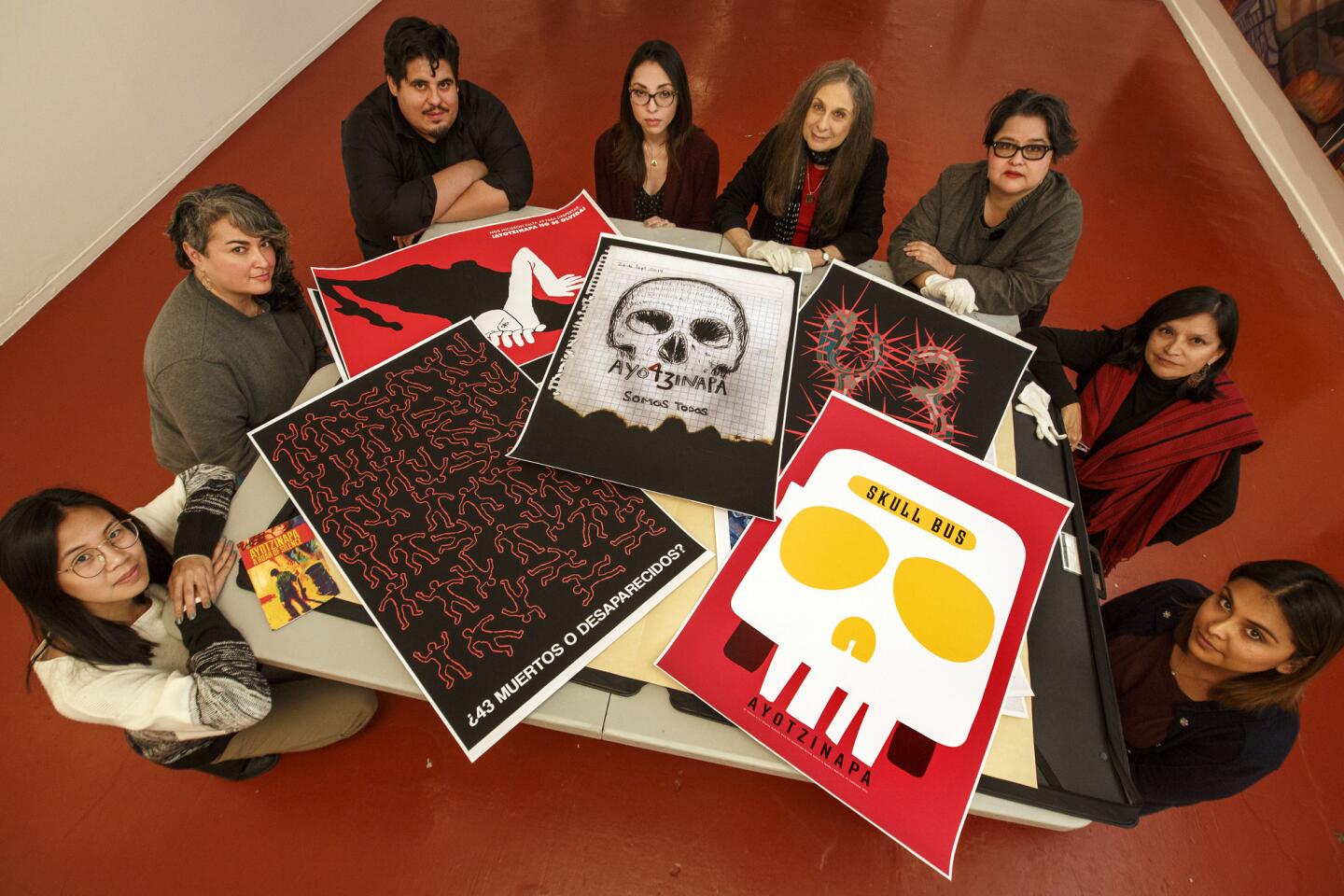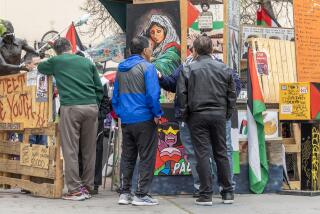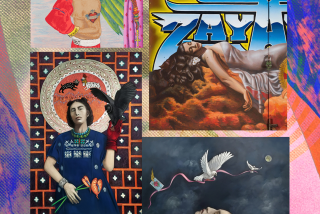A poster exhibit stopping in L.A. gives voice to Mexico’s missing 43 students
The poster, rendered in black and gray with a hint of red shows, a school bus disappearing into a dark plume of storm clouds, leaving bloody trails on the road behind it. A second poster depicts a charcoal-drawn skull on burnt notebook paper. Yet another has words etched into sand on a beach, the message as ephemeral as the wind that will blow it away: “Where are the Ayotzinapa students?”
The posters are an outcry by artists from 13 countries in response to the 2014 kidnapping in Iguala, Mexico, of 43 students on their way to a political protest. The government says the 43 young men from the Ayotzinapa Rural Teachers College were rounded up and killed by corrupt local authorities working with a drug cartel; a report by an international human rights group disputes details of the purported massacre. Bodies have not been found, and families of the victims are seeking answers.
See more of Entertainment’s top stories on Facebook >>
Shortly after the students went missing, noted Mexican activist and artist Francisco Toledo sent out a call through museums, universities and cultural organizations for original poster art giving voice to the tragedy. He received more than 700 responses from artists as far-flung as Denmark, Poland, Lebanon, Cuba and Argentina, with the largest number of entries coming from Iran. Forty-three of the posters formed the exhibition “Carteles de Ayotzinapa” at Mexico’s Museum of Tolerance. The exhibition, which traveled throughout Mexico and Latin America, now will open in Los Angeles.
Four local arts organizations dedicated to social justice — the Social and Public Art Resource Center, better known as SPARC, plus the Center for the Study of Political Graphics, Art Division and Self-Help Graphics & Art — have banded together to bring the exhibition, renamed “Ayotzinapa: A Roar of Silence,” to Los Angeles for its U.S. debut Feb. 18. It then will move on to the Netherlands and France.
“It’s to keep the awareness of what occurred and to keep the memory of the young men alive,” says Marietta Bernstorff, a visiting resident curator at SPARC who oversaw the L.A. exhibit. “And also to put a little bit of pressure on the Mexican government to resolve this and find answers for these parents.”
The collaboration came about after the Center for the Study of Political Graphics in Culver City decided to purchase a set of the 43 posters for its permanent collection. The center was referred to Bernstorff, who knows Toledo and helped the center purchase the posters from Toledo’s arts library and cultural center, Instituto de Artes Graficas de Oaxaca. Because the Center for the Study of Political Graphics doesn’t have an exhibition space, Bernstorff suggested that it collaborate on a show with SPARC.
Meanwhile, Self Help Graphics was already putting together an exhibition of local art in response to the Iguala events as well as to racism and police brutality closer to home. Art Division had been mulling programming ideas that would broach some of these issues. Bernstorff roped them in as well.
“We’re building threads of unity in order to survive,” Bernstorff says, “because we’re all small organizations, with similar struggles. We don’t survive alone, we survive as a unit.”
The Center for the Study of Political Graphics will lend its set of Ayotzinapa posters to all three organizations for separate, sequential exhibitions.
The 43 posters — along with 43 handmade white kites, each bearing the face of one missing student — will show at the Duron Gallery at SPARC through late March; Arts Division will exhibit them in April, then Self Help Graphics in May and June. Each staging of the exhibition will include programming, such as lectures, films and additional art.
SPARC, coincidentally located in a former Venice police station, will display a handmade cotton quilt by San Francisco artist Yolanda Guerra. Each of the missing students’ faces is embroidered onto the fabric around the saying: “Ayotzinapa: They tried to bury us. They didn’t know we were seeds.” And SPARC will screen a Vice News documentary, “The Missing 43: Mexico’s Disappeared Students,” as well as a minimalist film by Michael Nyman, “Witness 43,” with haunting music and images related to the Iguala kidnapping.
Art Division, an arts education nonprofit in MacArthur Park and founded by painter Dan McCleary, will pair the poster exhibit with a film screening and guest lecturer.
Self Help Graphics asked local street artist Vyal One to paint a mural on the side of its East L.A. building for the opening of the poster exhibition. It’s also staging “43: From Ayotzinapa to Ferguson,” featuring 43 original artworks — paintings, prints, installation pieces and performances that are in response to the kidnapping of the Mexican students or the 2014 shooting of Michael Brown by a police officer in Ferguson, Mo.
Memorial processions will take place on the day the poster exhibition travels to its next venue. The framed artworks will be transported in vehicles, but 43 students from UCLA, Otis College of Art and Design and other local schools will carry symbolic banners as they walk, take Metro or ride buses across the city. A traditional Oaxacan band will march along with them.
Bernstorff says she hopes the coordinated events bring attention not just to the Iguala tragedy but also to the greater issues of government corruption and police violence worldwide, particularly against men and women of color. In this way, “Ayotzinapa: A Roar of Silence” is as much about the Ferguson incident and the #BlackLivesMatter movement as it is about Iguala.
“We’re using that tragic incident as an example, but it’s not only about Mexico, it’s something going on all over the world, a crime against humanity,” Bernstorff says. “You cannot kill or eliminate anyone just because a police officer or government feels like it, to have a civilized society.”
Self Help Graphics included its broader exhibition to punctuate that point, says the organization’s associate director, Betty Avila.
“We’re living these parallel lives on both sides of the border,” Avila says. “There’s a police state here as well; we’re not that different.”
During his recent visit to Mexico, Pope Francis denounced violence, corruption and drug trafficking, but he didn’t publicly address the Ayotzinapa issue or meet with the victims’ families, even though they’d requested a meeting. The families plan to send Francis a document with information about their case.
Another goal of the “Ayotzinapa” exhibit, Bernstorff says, is to inspire artists to create works of substance and political protest as opposed to art that’s simply aesthetically pleasing.
“I think it’s important to really think about what the art is and maybe get away from what we tend to see at all the art fairs, which can be superficial. You can do great aesthetics, but it doesn’t mean you can’t say anything socially or politically,” she says.
Debra J.T. Padilla, the executive director of SPARC, said she’s proud that her group has sat outside the “arts for art’s sake” paradigm. “That has a role and purpose,” she says, “but we’ve been very diligent in our 40 years to amplify things that people might want to hear and be unapologetic about that.”
Three exhibits, staged by four organizations, rolling out over about 16 weeks — they all amount to an arts festival of protest. It’s also a statement about arts unity in the city, say the organizers, who are splitting the cost of the show.
“We’re all organizations that have stood the test of time in a challenging art environment,” Padilla says. “How fast we put this together, working together, it speaks to the power of the whole rapid-response idea.”
It all started with Toledo, 75, who received his country’s National Prize for Arts and Sciences in 1998. His Instituto de Artes Graficas de Oaxaca is putting together a book of 100 posters from the original submissions. It’s set to come out at the end of March and will be available at SPARC and Self Help Graphics. The Oaxaca institute is giving some poster and kite proceeds to the families of the 43 victims to help their search for answers.
There’s been much interest in the exhibit touring throughout California, says Carol A. Wells, the Center for the Study of Political Graphics’ executive director.
“It’s of extreme interest to the population of California, which has so many people from Mexico,” Wells says. “And it’s a human rights issue that could happen to anyone’s kids, so it’s universal.”
Art, she says, is the most powerful social justice tool in the world.
“A gun at your head can change how you act, but it can’t change your heart,” Wells says. “Art — not just visual, but poetry and theater — has the ability to change your heart and your mind, to expand your consciousness. It’s been central to every viable movement for social change throughout history. For protest, for education, for historical memory. And that’s what this is about.”
------------
‘Ayotzinapa: A Roar of Silence’
Where: Debuting at SPARC, the Social and Public Art Resource Center, 685 N. Venice Blvd., Venice
When: 11 a.m. to 5 p.m. Tuesdays through Saturdays
Admission: Free
Info: (310) 822-9560, sparcinla.org
More to Read
The biggest entertainment stories
Get our big stories about Hollywood, film, television, music, arts, culture and more right in your inbox as soon as they publish.
You may occasionally receive promotional content from the Los Angeles Times.












